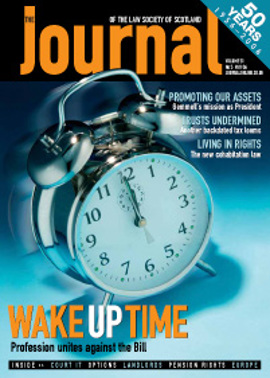Property problems

Property-related claims continue to account for relatively high numbers of Master Policy claims. Were it not for the recent floodgates of endowment mis-selling claims, property would rank highest of all the main practice areas in terms of overall frequency and value of claims.
That may be as expected, bearing in mind the number of property transactions handled by the profession and the fact that property work consistently accounts for the highest proportion of the profession’s fee income.
Many of the matters resulting in claims and complaints arise out of apparently routine conveyancing matters – matters overlooked in examination of title, searches or other documentation, omission in reporting to client or in reconciling missives/title conditions with the client’s expectations, etc.
Addressing the cost
There is clearly a cost impact on firms in terms of self-insured amounts, premium loadings, abatements, write-offs and lost fee earning time. Is this an unavoidable feature of providing property/conveyancing services for clients? Does this have to be viewed as an uncontrollable overhead of operating in this area of practice?
Case study
The partner with overall responsibility for risk management in a smaller firm took the view:
- that the firm’s experience of property-related problems, not just claims but also complaints, “near-misses” and write-offs over the course of recent years, was at an unacceptable level;
- that, if the complaints regime proposed in the Legal Profession and Legal Aid (Scotland) Bill is implemented, complaints might prove even more costly to the firm in the future;
- that most, if not all, the claims and complaints could have been readily avoided;
- that the time and out-of-pocket cost was capable of being reduced progressively year on year by targeted enhancements in the firm’s risk controls.
Benchmarking
In an ideal world, there would be a convenient method of benchmarking the firm’s performance according to factors including:
- the value of written-off work in progress, fees or outlays;
- the time spent on claims and complaints;
- the firm’s risk management performance.
However, the partner was more interested in benchmarking the firm at intervals against its own past performance to measure improvement as a result of planned enhancements to the practice’s client care and risk management procedures.
To establish a base line against which to compare future performance and measure progress/improvement, the partner established a log of all claims, complaints, near-misses, write-offs etc; and a time recording category to log the time spent by himself and colleagues in resolving these matters.
The log recorded:
- the self-insured amounts paid out by the firm on settlement of Master Policy claims;
- the Master Policy premium loading impact of each claim;
- any IPS awards incurred;
- the amounts of fees and outlays written off.
The partner calculated the overall cost to the firm over the latest five year period in terms of self-insured amounts, premium loadings, abatements, write-offs and lost fee earning time. The total “cost” amounted to a figure of £66,718 – a substantial five figure cost per partner (table below).
The other partners queried the time cost figure but ultimately had to accept it as a reasonable reflection of time involved in reading the problem file, discussing matters with colleagues, corresponding with the client, dealing with the Master Policy insurers and bringing the matter to a conclusion.
There was no denying the reality that, year in year out, the firm was having to generate more than £10,000 of fees just to cover all the costs of claims, complaints and other service failures.
Risk improvement plan
Having established base line information for measurement, the partner had the undivided attention of the other partners and their total support. That was half the battle and the partner turned his attention to devising a risk improvement action plan to tackle the causes and contributory factors of the errors, omissions and other service failures accounting for the practice’s current record.
Each claim, complaint and other item on the log was considered and systematically addressed in terms of cause(s), contributory factor(s), common denominators, responsible fee earner etc. In each case, in discussion with colleagues, a view was reached about how the problem could have been avoided. The preventive actions varied from case to case – in some cases a change to the practice’s standard documentation was called for; in some cases a change to the practice’s procedures. Sometimes a training need was identified; sometimes a different approach to supervision of colleagues.
The matters on the log included the following:
Case 1
The firm had acted for the seller of a small country estate. One of the partners had taken instructions from the client and the client had clearly specified that he wished to retain a two acre paddock for future development. The partner passed the file to an assistant who dealt with the missives and conveyancing. The assistant omitted to retain the paddock.
Risk management points:
The problem in this case apparently arose because of a failure to note/act upon the client’s specific instructions. Did this arise because of an omission on the part of the partner in relaying the client’s instructions to this assistant? Or were the instructions to the assistant perfectly clear? Should the assistant who is intended to handle the transaction always be present at the meeting at which the client’s instructions are taken? A clearly marked up plan would have assisted clarity between client, partner and assistant and served as a practical aide-memoire when drafting the missives/conveyance. When having the conveyance checked/signed by the client, it makes sense to draw the client’s specific attention to the description and plan and the rights conferred and reserved in the conveyance.
Case 2
The firm’s client purchased a plot from a local farmer to build a house on. It later emerged, when the building work had started, that the firm had omitted to provide for servitude rights for any of the essential services.
Risk management points:
When taking instructions from the client, it would assist to have a clear plan of the plot and to verify the ownership of surrounding land by discussion with the client and by checking the title. Using a checklist of issues to be addressed, methodically consider the requirement for rights for access and services as well as maintenance provisions. The plan could be marked up to reflect these points and an aide-memoire created.
Case 3
The firm dealt with the purchase of a house for a client. When the client came to sell the house, it emerged that a garage and bedroom extension added to the house by the client’s predecessor had been built on ground owned in common with neighbouring properties.
Risk management points:
The problem could have been avoided if warrant/permission plans/drawings were reconciled with title descriptions/plans and confirmed by the client and/or the client’s surveyor.
Case 4
Prior to settlement of their client’s house purchase, the firm overlooked one of the two outstanding securities disclosed in the interim search report and settlement took place on the basis that only one security required to be discharged.
Risk management points:
The search report had definitely disclosed both outstanding securities and this was a case of human error, an oversight in reading and noting the report while working under pressure of workload and deadlines. If a practice is adopted of ticking/initialling each entry on search reports, that ought to reduce the risk of simple oversight.
Case 5
The contract for the sale of a farm was silent in relation to VAT treatment. As a consequence, the sellers incurred an unexpected VAT liability for which they looked to their solicitors for reimbursement.
Risk management points:
The fee earner concerned had simply never considered the possibility that VAT might be an issue in this transaction. It was agreed to include reference to VAT implications in the sale checklist. At the same time, a prompt was incorporated in the firm’s style missives and missive clauses and terms of engagement.
Implementation and assessment
Having devised a risk improvement plan in respect of each matter, the partner:
- allocated to various colleagues responsibility for its implementation;
- set time limits for implementation;
- arranged with colleagues to review the implementation and effectiveness of new procedures and to test the level of risk awareness.
Two years on and the level of interest and activity had been sustained. The “cost” of claims, complaints etc was reported at every partners’ meeting and that remained a compelling incentive. The partners had been persuaded that effective risk management was an ongoing process. However, the partners were keen to know whether effective, measurable progress had been made.
The partners were referred to the level of risk management activity and risk improvements over the course of the two year period:
- risk management had been on the agenda at partners’ meetings;
- an action plan had been devised and implemented in respect of every new item on the claims log;
- internal training sessions now featured discussion on areas of risk for the firm and practical methods of minimising those risks;
- encouraged to do so, members of staff, including support staff, regularly referred to risk management and made suggestions for improvements;
- the firm now had a risk management manual;
- a risk management training plan was being regularly updated.
The partner demonstrated that the overall “cost” to the firm over the latest five year period in terms of self-insured amounts, premium loadings, abatements, write-offs and lost fee earning time had reduced to a figure of £19,635 (table above).
This represented a more tolerable level of cost although the partners continued to aim for continuous improvement. While risk management may not generate fees for the practice, the partners had achieved very worthwhile cost savings by their risk management efforts as well as improving client satisfaction and retention levels.
Instead of having to work ever harder, could your practice be more successful by operating “risk smarter”?
Alistair Sim is a Director in the FinPro (Financial and Professional Risks) Practice at Marsh, the world’s number one risk specialist. To contact Alistair, email: alistair.j.sim@marsh.com.
The information contained in this article provides only a general overview of subjects covered, is not intended to be taken as advice regarding any individual situation and should not be relied upon as such. Insureds should consult their insurance and legal advisors regarding specific coverage issues.
Marsh Ltd is authorised and regulated by the Financial Services Authority.
In this issue
- Stand up to be counted
- A bill to divide us
- The pendulum swings
- The pendulum swings (1)
- Cohabitation: the new legal landscape
- The tax man cometh (again)
- The foreign legion
- Making IT happen
- Apportioning and sharing
- Property problems
- Still a profession
- Arguing over agreements
- Next generation law
- Lawyers in the transfer market
- Scottish Solicitors' Discipline Tribunal
- Landlords: setting the mark
- Website review
- Book reviews
- Purchase options in leases






